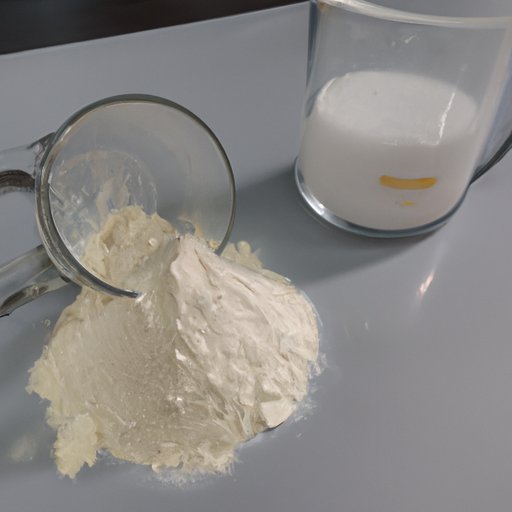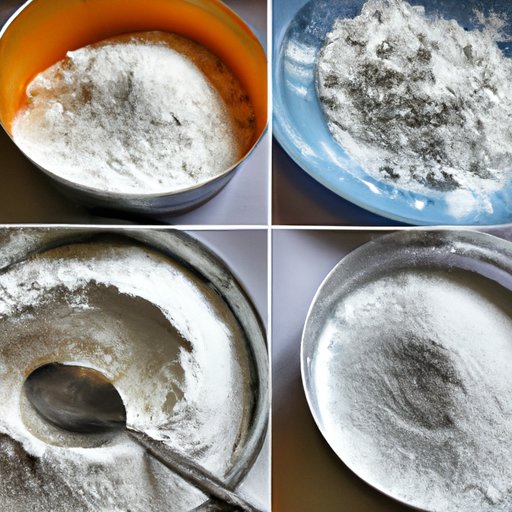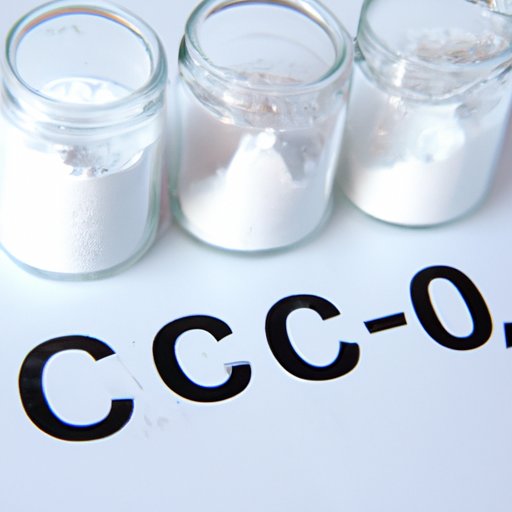Introduction
Baking powder is a dry leavening agent used in baking that helps doughs and batters rise when heated. It is a combination of baking soda, an acid, and sometimes other ingredients like cornstarch. When combined with liquid and heated, it releases carbon dioxide gas, which causes the food to expand. This expansion gives the food a light and airy texture, making it perfect for cakes, muffins, and other baked goods.
In this article, we will explore how baking powder works, the chemistry behind it, and the role it plays in baking. We will also provide a comprehensive guide to understanding how baking powder activates and releases carbon dioxide and how it affects the texture, flavor, and appearance of baked goods.

Exploring the Chemistry Behind Baking Powder
Baking powder is made up of three main components: baking soda, an acid, and sometimes other ingredients like cornstarch. Baking soda is a base, while the acid is typically cream of tartar or potassium bitartrate. The acid and baking soda interact with each other to produce carbon dioxide gas, which is what causes the food to expand.
The chemical reaction that occurs when baking powder is added to liquid involves the acid reacting with the baking soda to form carbon dioxide gas. This process is known as neutralization. The carbon dioxide gas then bubbles in the liquid and expands, causing the food to rise.

A Comprehensive Guide to Understanding How Baking Powder Works
Baking powder is activated when it comes into contact with liquid. The acid in the baking powder reacts with the baking soda, releasing carbon dioxide gas. This gas then bubbles in the liquid and expands, causing the food to rise. The process of releasing carbon dioxide gas is known as neutralization.
What happens when baking powder is added to liquid depends on the type of acid used. If an acidic agent like vinegar or lemon juice is added, the acid will react with the baking soda and release carbon dioxide gas. If a non-acidic agent like water is added, the baking soda will react with the acid and release carbon dioxide gas.
The role of acidic agents in baking powder is to help activate the baking soda and release carbon dioxide gas. Without an acidic agent, the baking powder will not be able to effectively release gas and cause the food to rise.
The Science of Baking: What Does Baking Powder Do?
Baking powder is used in baking to help create light and fluffy cakes, muffins, quick breads, and other baked goods. It helps to leaven the dough or batter and give it a light and airy texture. Additionally, it can help to improve the flavor and appearance of the finished product.
Different types of baked goods are best suited for different types of baking powder. For example, cakes and muffins are best suited for single-acting baking powder, while biscuits and quick breads are best suited for double-acting baking powder. Single-acting baking powder is activated by liquid, while double-acting baking powder is activated by both liquid and heat.

An Overview of the Role Baking Powder Plays in Baking
Baking powder is an essential ingredient in many recipes, from cakes and muffins to biscuits and scones. There are two types of baking powder available: single-acting and double-acting. Single-acting baking powder is activated by liquid, while double-acting baking powder is activated by both liquid and heat.
When using baking powder, it is important to follow the instructions on the package. Generally speaking, baking powder should be added to the dry ingredients first, followed by the liquid ingredients. It is also important to mix the ingredients together thoroughly before baking.
Unveiling the Magic of Baking Powder: How it Works to Make Delicious Treats
Baking powder is a magical ingredient that helps to transform simple ingredients into delicious treats. When baking powder is added to liquid and heated, it releases carbon dioxide gas, which causes the food to expand and become light and fluffy. This is why cakes, muffins, and other baked goods are so light and airy.
It is important to note that too much baking powder can have an adverse effect on baked goods. Too much baking powder can make them dense and heavy, so it’s important to measure carefully. Additionally, it is important to avoid mixing baking powder with acidic ingredients such as lemon juice or vinegar.
Conclusion
Baking powder is a dry leavening agent that helps doughs and batters rise when heated. It is a combination of baking soda, an acid, and sometimes other ingredients like cornstarch. When baking powder is added to liquid and heated, it releases carbon dioxide gas, which causes the food to expand and become light and fluffy.
Understanding how baking powder works is essential for creating light and fluffy baked goods. This article has provided a comprehensive guide to understanding the chemistry behind baking powder, its role in baking, and its effects on texture, flavor, and appearance of baked goods.
Using baking powder correctly can help to create delicious and light treats. However, it is important to remember that too much baking powder can have an adverse effect on baked goods, so it’s important to measure carefully and avoid mixing it with acidic ingredients.
(Note: Is this article not meeting your expectations? Do you have knowledge or insights to share? Unlock new opportunities and expand your reach by joining our authors team. Click Registration to join us and share your expertise with our readers.)
